“Generator Inspection Outages—Contingency Planning,” Jamie Clark, AGT Services.
Jamie Clark’s message was simple: Increased cycling of ageing gas-turbine (GT) assets, both simple cycle and combined cycle, is causing problems for owner/operators. The proof: Service providers say as much as 60% of their shop effort during outages now is emergent work (Fig 1). “We’re running older units harder than ever,” he continued, “harder than they were ever designed to run.”
The speaker recommended that attendees follow the latest guidelines regarding periodic inspections. These have changed recently, he said. One example: The most recent OEM guidance has no reference to field removal unless prior robotic inspections dictates via findings, or operational events—such as motoring, sync out of phase, generator trips, etc—warrant.
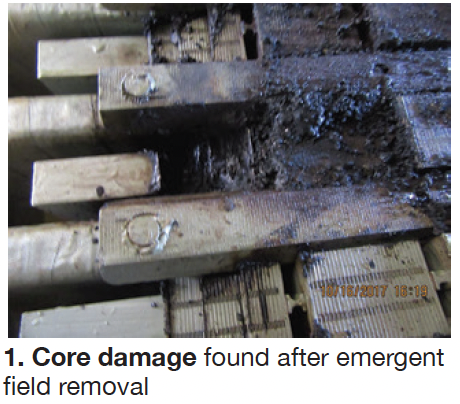
He also suggested users do the following before the outage:
- Take flux-probe
- Do EMI testing (refer back to the third item in the section above on user presentations).
- Conduct partial-discharge
- Review reports from, and since, the previous outage to review what was not done as
Clark next discussed the pros and cons of robotic inspection. At the top of the “pro” list is that robotic inspection avoids the cost and risk of field removal/reinstall. However, findings might suggest field removal, in which case you pay twice unless it’s possible to postpone work until the next outage.
The speaker called attention to the fact that robotic inspection equipment is a limited resource, especially with competent operators and generator specialists guiding the work. He suggested releasing robotic-inspection RFPs at least six months prior to the outage and ensuring service- provider commitments are in hand within three months of outage start.
Clark then reviewed reasons for pulling the field and explained work that can be done with the field in. The latter seemed particularly helpful to attendees. Here’s what he said regarding the stator: Minor endwinding repairs (tightening, partial-discharge damage, for example) are possible (Fig 2), as is belly-band tightening and possibly even core tightening—provided EL CID validation is possible.
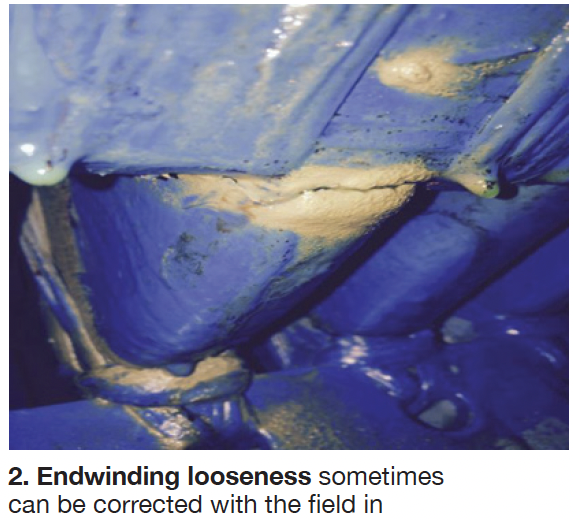
Concerning the field, collector-ring grinding and replacement typically are possible, along with brush-rigging repairs and upgrades. Retaining-ring NDE also can be done, in addition to a few other tasks.
If it becomes necessary to pull the field, Clark reminded, be sure the proper tooling is accessible—including coupling/journal shoes, skid pan, body shoe, slings, turnbuckles, and rigging from stator ends. Don’t overlook the benefits of field extraction platforms—for 7FH2s in particular, and possibly AeroPacs. This is not “incidental equipment, requiring possibly two 53-ft tractor trailers. Cranes are another consideration: A 7FH2 field weighs more than 75,000 lb, a GE 324 field about 50 tons. How close can the crane you need get into your unit? Access is almost always an issue (Fig 3).
Clark continued, “So now your field is out and you’ll be shipping it offsite, what do you need to know?” Come up to speed on permitting procedures and details. Figure it will take a couple of weeks to get a permit and line up trucking for the optimal route. Be aware of the permit time required and on-road time, the speaker said, advising that it’s rarely a good idea for an owner to manage shipping.
Doing field repairs? Figure seven to 10 days minimum, 30 days maximum for these typical repairs:
- Main-lead repair usually requires a No. 1 coil (both poles)—a partial rewind. But keep in mind that if you opt for this plan, the remainder of the field is “old.”
- Crossover repairs may require a full
- Slot armor delamination requires a full
- Turn shorts usually indicate a global condition: Rewind.
An exchange field might be the best course of action if operating commitments are firm. Keep in mind, the speaker said, that while all 7FH2s and 324s are the same mechanically, they can be different electrically—for example, in numbers of coils and turns per coil, etc. A few points to remember: Only accept an exchange with current high-speed balance and at-speed flux probe data, no turn shorts, high-quality vibration data, and assurance of interchangeability.
If field removal is in your plan, think about what stator repairs are prudent. Clark concludes his presentation with recommendations for rewedging, repairs to endwindings and connection rings, and a complete stator rewind. The last typically takes between 20 and 35 days, but may go to 12 weeks if bars must be replaced and they’re not available off the shelf.
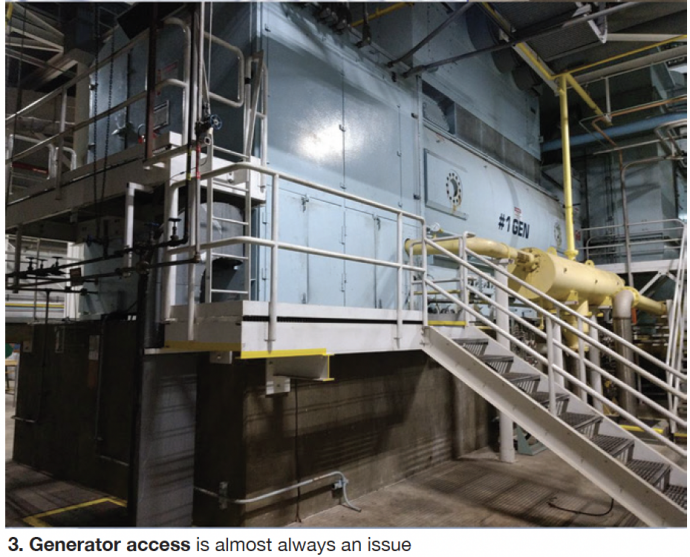
“Rotor Turn Insulation Failure,” Tyler Foutz, EthosEnergy Group.
Tyler Foutz’ short presentation concerned a rotor with 22k hours of run time that was exhibiting intermittent vibrations and flux-probe data discrepancies. Turn shorts were suspected and confirmed. The retaining rings were removed and endwindings inspected (Fig 4). Decision was to rewind. A root-cause analysis confirmed insulation failure and side-wall interference.
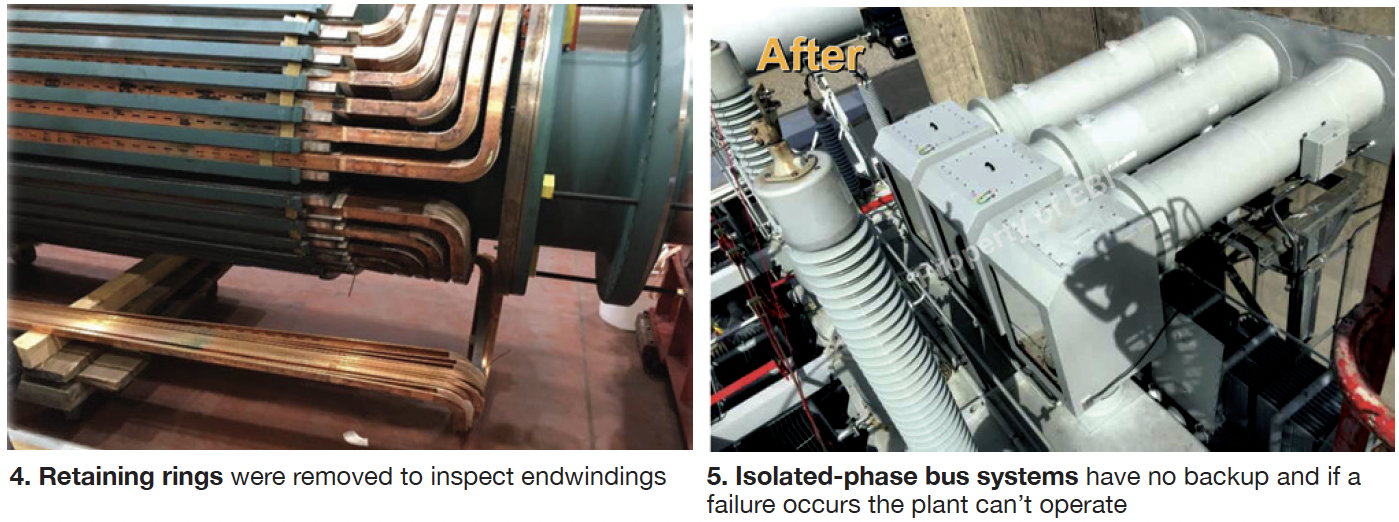
Repair quality was confirmed by high-speed balance/flux probe.
“What You Need to Know About the New IEEE Standard to Extend the Life of Your Existing Electrical Bus System,” Steve Powell, EBI-Electrical Builders.
Steve Powell, known to users for his insightful presentations at annual meetings, reviewed the design, construction, testing, and performance of bus systems, as established by IEEE C37.23- 2015 for metal-enclosed gear. He covered voltage ratings, rated insulation levels, continuous current, rated short-circuit and momentary withstand current, short-time withstand current, and temperature limits.
Powell reminded users that isolated-phase bus systems have no backup and if a failure occurs, the plant will be offline until the bus is repaired (Fig 5). He urged attendees to follow the OEM’s recommended service schedule (annually during a normal shutdown or every 18 months) and to confirm what you think you see (or don’t) with EMI testing and thermal imaging. He also discussed the value of periodic offline inspection and cleaning.
“Modification of a Westinghouse Stator from Diamond Coil to Bar Design,” Andrew Adam, PE, EthosEnergy Group, and Caleb Munholand, The High-Voltage Coil Manufacturing Co.
The RFQ for a generator stator rewind stated there would be no changes allowed to the nominal 54-MVA (13.8 kV) three-decades-old design except for insulation class (B to F). This stator was one of the largest diamond coils ever manufactured and the OEM and only one vendor still made the component. EEG, currently the OEM for legacy Westinghouse gas turbines and generators with access to original design prints and parameters, was the successful bidder.
EthosEnergy faced manufacturing challenges, as described in the well-illustrated presentation, motivating conversion to a Roebel bar configuration; design and manufacturing details are summarized in the slides. Because overall performance and output of the generator is largely dictated by the field, the speakers said, overall generator capability remained essentially unchanged. The new winding has the same number of turns as the original, resides in the same core iron, has the same amount of copper (or more), and has equivalent losses.
The stated advantages associated with specifying the three-turn Roebel bar design over the three-turn diamond coil are these:
- Elimination of top-strand heating. Temperatures within the winding are evenly distributed because of
- Elimination of installation issues associated with the diamond-coil design mitigates significant user schedule and performance
“Fiber Optic Generator Monitoring,” Derek Hooper and George P Dailey, PE, BPhase Inc.
Better techniques and instrumentation for monitoring the performance powerplant equipment are always welcome. The presenters focus on the use of fiber optics for reducing the risk of generator in-service issues caused by high core temperatures and loose wedges. The presentation includes many slides on development history for those interested in how the technology has evolved.
The stated value of the BPhase developments is the following:
- The core monitoring system can detect any excursion from normal core operating conditions. The data allows plant personnel to see a core thermal event in progress, enabling a controlled shutdown before serious damage
- The wedge tightness analysis system allows maintenance personnel to follow the degradation of the wedge package over time, enabling the planning of rewedging without need for disassembly or robotic inspection. This can predict coil wear through mechanical vibration and core damage through slot pounding—as the condition will be detected before significant damage can
While acknowledging that fiber-based systems cannot perform visual inspections, the presenters say they can certainly reduce operational risk from wedge tightness and core-related issues, thereby reducing overall risk during extended operation as necessary.
“Generator Degassing and Purging: Best Practices for Safe Plant Operation,” Christopher Breslin, Environment One Corp.
Hydrogen is explosive, colorless, and odorless, as well as difficult to contain. Yet it has been used widely as a generator coolant since the late 1930s because its windage/frictional losses are less than for air and it has excellent heat-transfer characteristics.
It is essential for plant personnel to know and understand the hazards associated with hydrogen and that all equipment for handling and storing this gas must be certified and maintained in top condition (Fig 6). Finally, because purging is an inherently complicated exercise, and can be dangerous if performed improperly, all personnel involved must be well trained, non-sparking tools must be used, carbon dioxide must be readily available in sufficient quantity, appropriate safety signage must be in evidence in critical areas, and keyed lockouts must be provided for “air” and “hydrogen.”
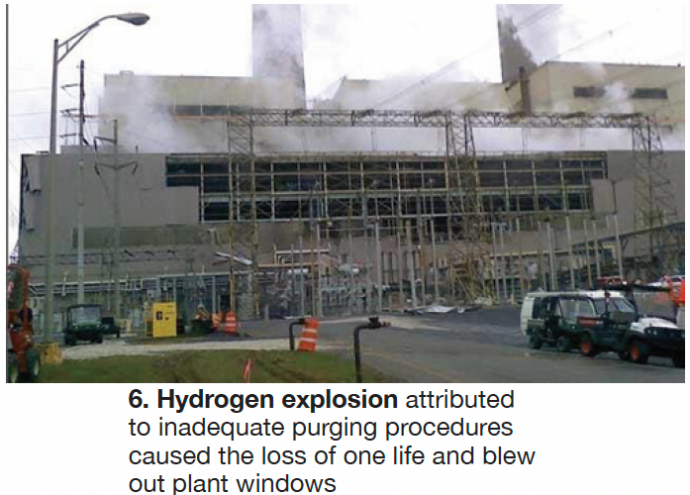
Chris Breslin, known by users for his practical and valuable presentations, reviews primary elements of the hydrogen auxiliary system, including useful one-line diagrams, provides guidelines for the purging process and best practices for safe plant operation, and reviews requirements/considerations for automated de-gassing. Consider the presentation for a lunch- and-learn session in the plant conference room.
“Comparison of Low- and High-Frequency Partial-Discharge Measurements on Rotating- Machine Stator Windings,” G C Stone and H G Sedding, Iris Power (Canada).
The speakers are among the industry’s top experts in the partial-discharge (PD) testing of electrical equipment. They draw the following conclusions in their relatively short but informative presentation: Low- and very-high-frequency PD detection methods in machines each have very different advantages. For offline applications, it is clear that low-frequency testing is preferred because PD can be better detected regardless of where it occurs in the winding.
For online testing, of transformers for example, the very-high and ultra-high methods are preferred by users because the risk of false indications caused by noise is lower; therefore, test credibility is higher.
To dig deeper on the subject, read “PD Monitoring Helps Guide Stator-Winding Maintenance,” by G C Stone, Iris Power (Canada), published in CCJ No. 61 (2019), p 100. You can access it by using the search function on the CCJ home page at www.ccj-online.com.
“Realities of Global Vacuum Pressure Impregnated (GVPI) Impregnated Generator Stator Repair and Rewind,” W Howard Moudy, NEC-National Electric Coil.
Howard Moudy may have made more presentations at user-group meetings in the last decade than anyone else—in the process covering all types of generator failures and their fixes. At the 2019 GUG conference his topic was the repair and rewinding of a GVPI stator for a 13-yr-old, 100-MVA, air-cooled generator serving a geothermal plant in Indonesia. The unit tripped with damage to the winding and core (Fig 7). Contributors to the failure as determined by a root- cause-analysis investigation included the following:
- Endwinding vibration/resonance.
- Core looseness/hot spots.
- Key-bar deterioration at the core exit—ground-wall fretting and thermal deterioration, and strand
- Vibration transmitted from the phase-ring
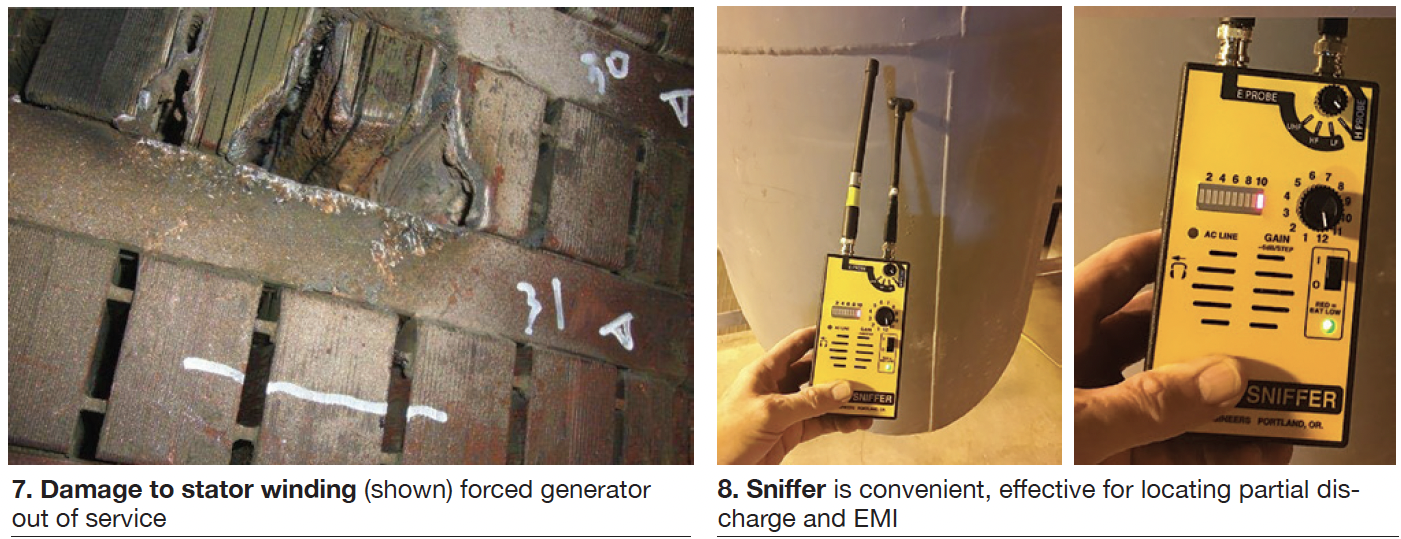
The owner expressed preference for mechanical removal of the winding despite NEC’s deep experience with the generally preferred water-blasting process. The contract was awarded to a local company with NEC in an oversight role. The local firm was able to complete the job with NEC’s help and tooling. However, other findings created uncertainties in the customer’s mind that led to replacing the entire core. A couple of dozen photos describe the work.
NEC came away from the project with the confidence in its ability to rapidly rewind/rebuild air-cooled GVPI stators anywhere in the world. In this case the time to manufacture a new stator winding and ship it to Indonesia was 38 days.
In his concluding remarks, Moudy acknowledged that the initial cost of GVPI generators is attractive but that there are maintenance concerns and limitations associated with a decision to go with GVPI. Finally, he said that with proper engineering and planning, GVPI generators can be rewound effectively to a coil VPI design that is more easily maintained and conducive to long- term reliable operation.


